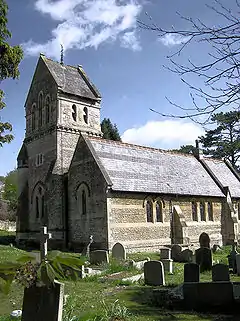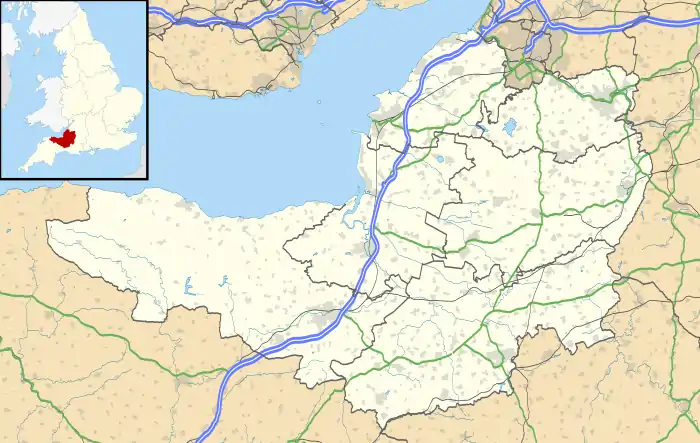Monkton Combe
Monkton Combe is a village and civil parish in north Somerset, England, 3 miles (4.8 km) south of Bath. The parish, which includes the hamlet of Tucking Mill, had a population of 554 in 2013.[1] It has also been called Monckton Combe and Combe Monckton/Monkton.
History
Monkton Combe was part of the Anglo-Saxon era hundred of Bath Forum.[2][3]
According to Rev. John Collinson in his History of Somerset (1791), the village's original name was Combe, with the Monkton element being attached as an adjective to differentiate it from neighbouring Combe Down and Combe Grove. The village was originally owned by the monks of Bath Abbey, hence Monkton Combe.
It was on the route of the (now disused) Somerset Coal Canal, which ran parallel to Midford Brook.
Monkton Combe railway station featured in the 1953 film The Titfield Thunderbolt, one of the Ealing comedies. The film's plot centred on efforts by villagers to preserve their local railway line. It was on the short-lived branch line of the Bristol and North Somerset Railway which went from Limpley Stoke to Camerton and had closed to passenger traffic in 1925, though the line was used for freight traffic from the Somerset coalfield until 1952.
Governance
The parish council has responsibility for local issues, including setting an annual precept (local rate) to cover the council’s operating costs and producing annual accounts for public scrutiny. The parish council evaluates local planning applications and works with the local police, district council officers, and neighbourhood watch groups on matters of crime, security, and traffic. The parish council's role also includes initiating projects for the maintenance and repair of parish facilities, such as the village car park and playgrounds, as well as consulting with the district council on the maintenance, repair, and improvement of highways, drainage, footpaths, public transport, and street cleaning. Conservation matters (including trees and listed buildings) and environmental issues are also of interest to the council. The Village Hall and Village Green are the responsibility of the Village Hall Committee and not of the Parish Council.
The parish falls within the unitary authority of Bath and North East Somerset which was created in 1996, as established by the Local Government Act 1992. It provides a single tier of local government with responsibility for almost all local government functions within its area including local planning and building control, local roads, council housing, environmental health, markets and fairs, refuse collection, recycling, cemeteries, crematoria, leisure services, parks, and tourism. It is also responsible for education, social services, libraries, main roads, public transport, Trading Standards, waste disposal and strategic planning, although fire, police and ambulance services are provided jointly with other authorities through the Avon Fire and Rescue Service, Avon and Somerset Constabulary and the Great Western Ambulance Service.
Bath and North East Somerset's area covers part of the ceremonial county of Somerset but it is administered independently of the non-metropolitan county. Its administrative headquarters is in Bath. Between 1 April 1974, and 1 April 1996, it was the Wansdyke district and the City of Bath of the county of Avon.[4] Before 1974 that the parish was part of the Bathavon Rural District.[5]
The parish falls within the 'Bathavon South' electoral ward. The ward starts in the north east at Monkton Combe and stretches south west through Wellow to Shoscombe. The total population of this ward at the 2011 census was 3,052.[6]
The parish is represented in the House of Commons of the Parliament of the United Kingdom as part of the North East Somerset constituency.[7] It elects one Member of Parliament (MP) by the first past the post system of election.
Religious sites
The parish church of St Michael, thought to have been Norman, was razed in the early 19th century and rebuilt in 1814. The 1814 church was soon found to be too small, and was rebuilt in 1865 at the initiative of the first Vicar of Monkton Combe, the Revd. Francis Pocock. It was designed by ecclesiastical architect C. E. Giles of London, and the builder was Mr. S. G. Mitchell. It was extended within just a few years to accommodate the growing number of pupils from nearby Monkton Combe School, founded by Revd. Pocock in 1868. The church is a Grade II listed building.[8]
The churchyard contains the grave of Harry Patch, the last surviving British soldier who served in the First World War, and a handful of Commonwealth War Graves.
Landmarks

The village has one public house, the Wheelwright's Arms, which was built as a private house in the mid-late 18th century.[9]
There are two mills, neither of which is in working order. The Old Mill (a former flock mill) was built in the early-mid 19th century.[10]
A village lock-up was built in the 18th century, probably circa 1776. This is now a Grade II listed building[11] and an Ancient monument.
School
A significant proportion of properties in the village are owned and occupied by Monkton Combe School, an independent Christian boarding and day school in the English public school tradition, which was founded in the village in 1868 by the first Vicar of Monkton Combe, Revd. Francis Pocock.
Gallery
 The main street, with the school on the left
The main street, with the school on the left Part of the village, looking south-west. The unusual pitched-roof church tower can just be seen in the centre of the view
Part of the village, looking south-west. The unusual pitched-roof church tower can just be seen in the centre of the view Part of the main street, from the fields above
Part of the main street, from the fields above
References
- "Monkton Combe Parish". Neighbourhood Statistics. Office for National Statistics. Retrieved 31 December 2013.
- Reverend John Collinson (1791). The History and Antiquities of the County of Somerset. 1. p. 97. ISBN 978-1-171-40217-6.
- "Somerset Hundreds". GENUKI. Retrieved 9 September 2011.
- "The Avon (Structural Change) Order 1995". HMSO. Archived from the original on 30 January 2008. Retrieved 9 December 2007.
- "Bathavon RD". A vision of Britain Through Time. University of Portsmouth. Retrieved 4 January 2014.
- "Bathavon South ward 2011". Retrieved 8 March 2015.
- "Somerset North East: New Boundaries Calculation". Electoral Calculus: General Election Prediction. Archived from the original on 14 February 2009. Retrieved 19 September 2007.
- "St. Michael's Church". historicengland.org.uk. English Heritage. Retrieved 18 July 2010.
- "The Wheelwright's Arms". historicengland.org.uk. English Heritage. Retrieved 18 July 2010.
- "The Old Mill". historicengland.org.uk. English Heritage. Retrieved 18 July 2010.
- "Lock-up". historicengland.org.uk. English Heritage. Retrieved 18 July 2010.
External links
| Wikimedia Commons has media related to Monkton Combe. |

